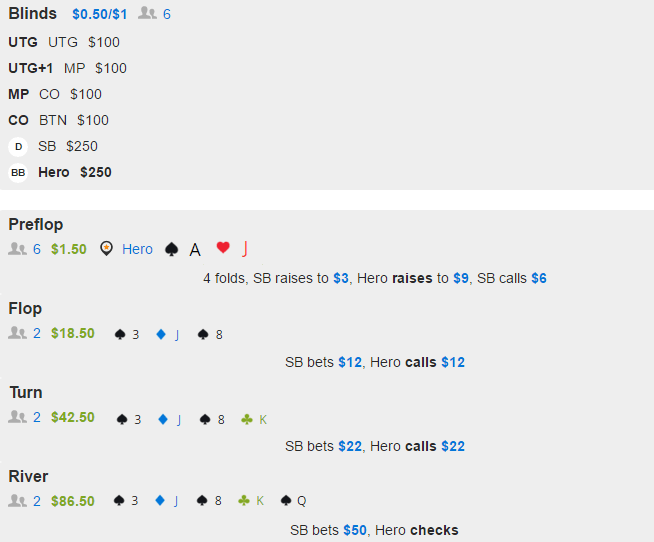Bluffing in poker is the act of betting or raising with a weak hand to convince opponents you hold a strong hand, forcing them to fold better cards. For winning poker players, mastering this skill is non-negotiable: it transforms marginal situations into profitable ones. In Texas Hold’em and other poker variants, bluffing will help you win pots without the best hand, increase poker winnings, and keep opponents guessing about your strategy.

Table of Contents
What is a Bluff in Poker, and Why Bluffing is an Important Skill?
A bluff is any bet or raise made when your hand is unlikely to win at showdown. There are different nuances when it comes to bluffing:
- Simple Bluff: A one-time bet with no plan for future streets (e.g., betting a weak hand on the flop and folding if called).
- Successful Bluff: A calculated deception that considers player types, table image, and pot odds to force folds consistently.
Bluffing is an important poker strategy because it balances your betting range (mixing bluffs with value bets), exploits opponents who fold too often, and maximizes profit in cash games and tournaments.
Types of Bluffs in Poker: From Continuation Bet Bluff to Semi-Bluff
Mastering different types of bluffs is critical for winning poker players, whether you’re grinding online poker or sitting at a live poker table.
Bluffing strategically helps you steal pots, pressure opponents, and boost your poker winnings.
Below, we break down the three most common bluffs and how to use them effectively in Texas Hold’em and other card games.
#1 Continuation Bet Bluff
Scenario: You raise pre-flop from late position, and the flop comes disconnected (e.g., K♦-7♠-2♥).
Goal: Use your pre-flop aggression to represent a strong hand, forcing folds from players who missed the board.
Execution:
- Bet 50-70% of the pot on the flop, even if your hand (e.g., J-10) didn’t connect.
- Works best heads-up or against tight players in the big blind who fold to post-flop pressure.
#2 Semi-Bluff
Hand: Bet with a flush draw (e.g., 9♣-8♣ on a Q♣-5♣-2♦ flop) or straight draw (e.g., J-10 on a 9♠-8♦-2♥ flop).
Edge
- Retain equity to improve on the turn or river (e.g., a 35% chance to hit your flush by the river)
- Apply pressure while keeping a backup plan if called
- Bet or raise on the flop and turn to represent a made hand
- Ideal against cautious opponents who fold to aggression
#3 Stone-Cold Bluff
Hand: Bet with pure air (e.g., 7-2 offsuit on an A♠-K♦-Q♥ flop).
Risk
- High risk-requires perfect timing and a strong read on opponents
- Best used against tight players who fold to large bets, especially on scary boards
- Tell a believable story (e.g., represent AA after raising pre-flop)
- Avoid this against players in the hand who won’t fold or have bluff catchers
When to Use Each Bluff
| Bluff Type | Best Scenario | Risk Level | Key Advantage |
| Continuation Bet | Dry flop, heads-up pots | Moderate | Capitalizes on pre-flop image |
| Semi-Bluff | Flop and turn with draws | Low | Combines equity + fold chance |
| Stone-Cold Bluff | Tight opponents, polarized boards | High | Pure deception for max profit |
- Continuation bet bluffs work well in cash games where players respect aggression.
- Semi-bluffs are safer in low stakes games where opponents chase draws.
- Stone-cold bluffs shine in advanced poker against observant players.
Best Times to Bluff: When to Try to Bluff a Player
Bluffing is most effective when you consider player types, table image, and stack sizes. The best times to bluff are when your opponents are likely to fold and the board supports your story.
Player Types
- Tight player poker bluff: Tight players fold more often, especially if the board is scary or you show strength. These are ideal targets when you try to bluff a player.
- Loose players: Loose players call with a wider range and are difficult to bluff. Against them, bluff less and focus on value betting.
Table Image
If your table image is tight (you’ve played few hands), your bluffs get more respect.
If you’ve been bluffing a lot, players at the table may call you down lighter, so bluff less frequently.
Stack Sizes
Deep stack sizes give you more room to apply pressure across multiple streets (flop, turn, river).
Short stacks reduce your bluffing options, as opponents are more likely to call with marginal hands.
Never Bluff Calling Stations
The rule of thumb: If a player is known for chasing every draw or calling every bet, it is better to wait for a strong hand.
Understanding Showdown Value
An understanding of showdown value is critical to understanding how to bluff. In short, you want to pick spots where you cannot win at showdown. Take the spot below for example:

In this hand, your opponent has barreled the flop and turn into you out of position, and then checked the river.
Imagine you held 6h 7h here. Your flush and straight draws missed, and you find yourself holding 7 high. You can only win by bluffing.
On the other hand, imagine you held Ah 3h. Your draws missed, but you still hold a pair on a board where your opponent was likely barreling a ton of straight draws and flush draws. It makes sense to check behind and take the chance at winning at showdown.
The Value of Blockers
An ideal bluffing hand has blocker value. This means that you hold cards that would otherwise be part of your opponent’s calling range.
Imagine you find yourself in this spot. For now, let’s ignore strategy and simply look at how the cards you hold affect your opponent’s range.

Because you hold on the Ace of spades, there are 9 less possible flush combinations that your opponent can hold (he cannot have As2s – AsKs).
As your opponent cannot hold the nut flush, and you are deep, you have the opportunity to represent the nut flush with a bluff.
You know he cannot hold the nuts because you are blocking it.
Similarly, it’s reasonable that your opponent would lead into you here with a set, like JJ. Because you hold the Jc, and the Jd is on the table, only one out of 6 combinations of JJ (JhJs) is possible.
Likewise, by removing one of four aces, you reduce the number of AT combinations your opponent can hold by 25%. These are hands with which your opponent might call your bluff, otherwise known as bluffcatchers,
As you can see, having AsJx in this spot significantly cuts down on both your opponent’s nut hands and bluffcatchers. Thus, your AsJx has good blocker value.
How to Execute a Bluff in Poker: Step-by-Step Guide
Bluffing well requires a plan from pre-flop to showdown. Here’s how to execute a bluff effectively:
1. Pre-Flop
Identify the right spot. If you’re in late position and the action folds to you, consider raising with hands that can represent strength or have potential (like suited connectors for a possible flush draw or straight draw).
2. Flop
If you raised pre-flop and the flop misses your hand, a continuation bet bluff can force folds, especially if the board is dry (few draws possible).
Choose a bet size that puts pressure on opponents-typically 50–70% of the pot.
3. Turn
If your flop bet is called, assess the situation. If a scare card hits (like an ace or a third suited card), you can fire another barrel to represent a strong hand.
Consider your chip stack and the remaining pot odds.
4. River
If you reach the river and believe your opponent has a weak hand, a final bet can get them to fold.
Make sure your story is consistent from pre-flop through river. If your bets look like a value bet with the best hand, the bluff is more believable.
5. Showdown
If you get called, be prepared to show your cards or muck. A successful bluff is one where your opponent folds before showdown.
Our Professional VIP-Grinders Tips
- Always read the players in the hand. If they seem unsure or hesitant, your bluff is more likely to succeed
- Bluff well by representing a logical strong hand throughout the hand
- Use your table image to your advantage-if you’ve been playing tight, your bluffs will be more credible
Bluff More Often, Bluff Less, and Adjust to Player Types
Bluffing frequency should always match the player types and the stakes games you’re playing. In low-stakes or micro-stakes games, most players are “call-happy,” so it’s smarter to bluff less and focus on value betting. As you move up in stakes and face more observant opponents, you can bluff more often and balance your range.
Bluff More Often
- Target opponents who fold too much, especially after missed draws or on scare cards.
- Use advanced moves like the river bluff or polarized bets when you sense weakness.
- Tight players or those who overfold are prime candidates for frequent bluffs.
Bluff Less
- Avoid bluffing against players who call down with any pair or draw. These players are called “calling stations” and are common at micro and low stakes.
- In multi-way pots, bluff less – more players mean a higher chance someone has a strong hand.
Spotting an Opponent’s Bluff
Watch for sudden aggression from passive players, odd bet sizing, or inconsistent stories.
In online poker, use stats like 3Bet% by position to catch frequent bluffers.
In live games, look for physical tells: excessive talking, nervous chip handling, or sudden changes in demeanor.
Bluff Catcher and Value Bet
A bluff catcher is a medium-strength hand that beats bluffs but loses to value bets. Use these hands to call down frequent bluffers, especially on dry boards.
When you spot someone bluffing a lot, shift your strategy to value bet more often and call them down lighter.
Advanced Poker Bluffing Concepts
Bluffing a lot is rarely optimal; instead, focus on bluffing enough to keep opponents guessing but not so much that you get caught frequently.
Use “polarized” bluffs-representing either a strong hand or nothing at all-to pressure opponents into tough decisions.
Adjust your bluffing frequency based on your table image. If you’ve been caught bluffing recently, tighten up and value bet more.
Bluffing in Online Poker and Live Poker: Differences and Similarities
Bluffing dynamics shift between online poker and live games at the poker table.
| Format | Bluffing Frequency | Best Targets | Key Skills | Useful Tools |
| Online Poker | Lower at micro | Tight/folding players | Pattern recognition | HUDs, stats, replays |
| Live Poker | Higher at mid/high | Weak/timid opponents | Reading physical tells | Table image |
In online poker, players rely on betting patterns, timing, and digital stats-physical tells are absent.
Bluff at the micro stakes is less effective since players call more often; focus on value betting and only bluff in the right spots.
Use online tools and HUDs to track opponents’ tendencies and spot frequent bluffers.
The volume is higher, so you see more hands and more situations to practice your bluffing.
Live Poker
- Physical tells, table talk, and demeanor play a bigger role.
- Players at the table tend to call less often with weak hands, especially at higher stakes.
- You can use your presence and table image to influence opponents’ decisions.
Tips for Micro and Low Stakes Games
At micro and low stakes, bluff less and value bet more. Players are less likely to fold, especially on draw-heavy boards.
Look for an opportunity to bluff only when the board is dry and your opponent is likely to fold.
Improving Your Bluffing with Online Poker Content
Study hand histories, watch replays, and review your own bluffs to see what works.
Follow poker strategy articles and videos focusing on bluffing in both online and live formats.
Use forums and online communities to discuss hands and get feedback on your bluffing approach.
Bluffing is a core part of poker, but the best strategy is always to adjust to your opponents, the stakes, and the format you’re playing. Use these advanced tactics to maximize your edge, whether you’re grinding online or sitting at a live poker table.
Why It’s Smarter to Fold Than Try to Bluff When You Know You Are Beat
Many poker players lose chips by bluffing a lot in the wrong spots. Here are the most common mistakes to avoid:
Bluffing a lot against players who call down with any pair or draw. These are the classic “calling stations” and are difficult to bluff.
Ignoring your chip stack and overall stack sizes. Bluffing with a short stack rarely works because opponents are more likely to call, knowing you can’t apply pressure on future streets.
Trying to bluff a player who is a known bluff catcher. Some players love to call with marginal hands just to catch a bluff.
Using a bluff bet like a weak player-small, hesitant bets that don’t put real pressure on opponents. Good players will sniff these out and call you down.
Not paying attention to the board texture or the number of players in the hand. Bluffing into multiple opponents or on wet boards (many draws possible) is rarely profitable.
Why it’s better to get out of the hand when you know you are beat
If you sense your opponent is strong, or they call your bluff with confidence, it’s better to fold and save your chips for a better spot.
Don’t try to force a bluff just because you’ve invested chips in the pot. A disciplined fold keeps your stack healthy and avoids providing away more information about your play style.
To avoid getting called like a weak player
- Only bluff when your story makes sense and you can credibly represent a strong hand
- Pay attention to your opponent’s tendencies and avoid bluffing those who rarely fold
- Use proper bet sizing to apply real pressure-don’t make small, timid bluffs
Conclusion
When considering potential bluffs, look for hands with drawing value, good blocker value, and hands that lack showdown value.
Finally, remember not to bluff too much – some opponents, especially at lower stakes, will just not let go of their hands.
Frequently Asked Questions About Bluffing in Poker
How often should you bluff in poker?
There is no fixed percentage for how often you should bluff in a poker game. Bluffing frequency depends on the situation, including your position, the board, and the player types at the table. In general, you should bluff less at lower stakes and against players who call often. In higher stakes or against tight opponents, you can bluff more often, especially in late position or when it folds to you in the big blind. Adjust your bluffing frequency based on how likely your opponents are to fold after the flop and turn.
What is the rule of thumb for bluffing frequency?
A common rule of thumb for bluffing is to match your bluff frequency to your opponent’s pot odds. For example, if you bet the size of the pot on the river, your opponent is getting 2-to-1 odds, so you should bluff about one-third of the time. The formula is:

If you bet half the pot, bluff about 25% of the time. Bluff more often on the flop and turn, and less on the river, because your equity with weak hands drops as the hand progresses.
How do you know if someone bluffs or if an opponent’s bluff is credible?
Spotting if an opponent is bluffing involves observing betting patterns, body language, and bet sizing. In live poker, look for nervousness, inconsistent stories, or sudden aggression post-flop. If a player bets big on the flop and turn but slows down on the river, they might be bluffing. In online poker, watch for players who bluff often with large bets or those who suddenly change their betting habits. If a player is making big bets from the big blind or in late position after the flop and turn, and their story doesn’t add up, their bluff may not be credible.
When should you show your cards after a bluff?
Show your cards after a bluff only if you want to influence your table image. Revealing a successful bluff can make players in the hand think you bluff often, which might get you paid off with strong hands later. However, in most poker games, it’s better not to show your cards. Keeping your opponents guessing about whether you had the best hand or were bluffing gives you an advantage in future hands.



















